March 20 - 26, 2022: Issue 531
Pittwater's Torpedo Wharf
The passing of Bill Fitzgerald OAM this month, renowned clearance diver with the Royal Australian Navy, who received an OAM for ‘‘service to diving, and to the development and training in the use of life support breathing apparatus'', inspires a dual tribute this Issue.
Bill started the Diving Training at Clareville, at the RAN's Pittwater Annex. However his first month in Clareville was in October 1948. He was testing and maintaining torpedoes and trialling them in Pittwater to the 3000 yard target.
As seen in Naval Visits to Pittwater 1788-1952 the testing of torpedoes in Pittwater has numerous instances prior to the establishment of the torpedo wharf at Taylor's Point.
Marine Notices would appear in local papers, advising of the activities:
TORPEDO PRACTICE AT PITTWATER.
Shipmasters and others are hereby notified that Torpedo Practice will take place In Pittwater, commencing on 10th October, and continuing dally (Saturdays and Sundays excepted) until 27th October, 1933. Practice will only take place between the hours of 8 a.m. and 12 noon, and between 1 p.m. and 4p.m. Torpedoes will be fired from a destroyer anchored towards the southern end of Pittwater, near Taylor's Point, in a northerly direction of Observatory Point. Mark buoys will be laid at the northern end of torpedo range. A red flag will be flown by the destroyer while practice is in progress, and a red flag will be flown by a motor launch in the vicinity of Rock Head, when range is dangerous. Vessels are not to proceed south of Observation Head or north of destroyer when these signals are flying.
The signal (Black Ball over the International Code signal K.J.Y.), will be flown with small size flags from a boat fitted with a mast anchored in the fairway, about 440 yards to the north of the torpedo range limit. Advertising. (1933, October 7). The Sydney Morning Herald (NSW : 1842 - 1954), p. 1. Retrieved from http://nla.gov.au/nla.news-article17013385
With the outbreak of World War II the testing of defence equipment became vital. The RAN operated a torpedo range at Taylors Point from 1941 to 1983, to test the firing ability and the range of torpedoes before they were issued to submarines. In total 5059 torpedoes were fired from Taylors Point up Pittwater. Navy launches cleared small craft from the firing area, a large red warning flag was unfurled from the firing shed and a siren sounded.
Three pontoons were positioned in the water from which the speed and accuracy of the torpedo’s course were registered and relayed back in the firing tower. The torpedoes were then retrieved by a patrolling launch. In 39 years only three of the torpedoes went awry, luckily with no human casualties. [1.]
On the 26th of March 1941 the trawler Millimumul was sunk east of Broken Bay after hitting a mine laid by Pinquin, a German auxiliary cruiser. As May became June in 1942 torpedoes from Japanese miniature subs were fired at Bondi, Bellevue Hill and into Sydney Harbour, sinking HMS Kuttabl and killing some of the young men billeted onto this vessel. As early as 1940 Australia began to lose ships to mines laid by German vessels off our Victorian coast and ships further at sea to torpedo attacks. Protection against further attacks and preparations against invasion were crucial. The manufacture of torpedoes within Australia, decentralising this weaponry production from Britain, came as a request from Admiralty.
The Australian War Museum states:
TORPEDOES AND MINES
THE decision to manufacture torpedoes in Australia, taken at a meeting of the War Cabinet on 22nd December 1941, committed the country 's precision engineering to a most difficult undertaking; by reason of the position occupied by torpedoes among modern armaments, the undertaking was one of great potential importance . With sea power as the corner-stone of Britain's dominant strength among world powers in the nineteenth century it is not surprising that the development of the torpedo was essentially a British achievement, though it was not in the first instance a British invention). Britain's early lead in the adoption of the torpedo owed much to the enthusiasm of Commander (later Admiral Lord) Fisher, but other great powers were not long in entering the field. The tremendous possibilities of the weapon were first apparent during the war of 1914-18 when Germany, by means of the U-boat and the %20building%20housing%20torpedo%20firing%20gear.jpg?timestamp=1368904468593) torpedo, inflicted such heavy losses on merchant shipping that she very nearly brought Great Britain to her knees. During the two decades that followed the first world war the torpedo acquired even greater destructive potentialities by the development of methods for dropping it from aircraft, and no great insight was required to predict the part the torpedo would play in a future war.
torpedo, inflicted such heavy losses on merchant shipping that she very nearly brought Great Britain to her knees. During the two decades that followed the first world war the torpedo acquired even greater destructive potentialities by the development of methods for dropping it from aircraft, and no great insight was required to predict the part the torpedo would play in a future war.
The manufacture of torpedoes in Britain was carried out principally by a private firm, the Whitehead Torpedo Company, which manufactured for all corners, and by the Admiralty at Greenock, Scotland . In July 1941 the Admiralty, concerned at the possibility that Britain 's production of torpedoes might be hindered if not prevented altogether by bombing or invasion, began to investigate means of providing alternative centres for such an emergency. Manufacture in Britain had been decentralised as far as practicable but nothing had been done towards establishing centres outside Britain.
The final and most important of all the tests applied to a torpedo was ranging, which consisted of firing it from a discharge tube located on shore over a carefully selected stretch of water. During ranging the war head was replaced by a dummy head filled with water. At the end of the run the water was expelled and replaced by air, which caused the torpedo to float upright and so made it easy to recover. The direction, depth and speed were closely observed and noted with special instruments.
THE BUILDING HOUSING THE TORPEDO FIRING GEAR AT THE RAN TORPEDO FIRING RANGE AND THE JETTY OF THE RAN TORPEDO RANGE, LOOKING LANDWARD, SHOWING THE TRAMWAY IN USE. (NAVAL HISTORICAL COLLECTION). Images no: 306035 and 306036, courtesy Australian War Memorial.
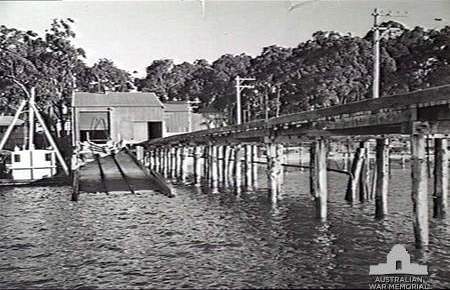 A range surveyed by the Hydrographic Branch of the R .A.N. was set up at Pittwater, in Broken Bay, 30 miles north of Sydney. Firing tubes, observation station, workshop, pier and target rafts were designed and erected while the torpedoes were being made. Normally every torpedo was ranged twice.
A range surveyed by the Hydrographic Branch of the R .A.N. was set up at Pittwater, in Broken Bay, 30 miles north of Sydney. Firing tubes, observation station, workshop, pier and target rafts were designed and erected while the torpedoes were being made. Normally every torpedo was ranged twice.
The ranging of the first Australian-made torpedo at Pittwater on 24th February 1944 was a signal success ; it sailed straight through all Admiralty tests without needing any of the small adjustments that are often called for in a first trial. The range officer, Lieutenant Owens, reported, "the performance of this torpedo could not be bettered" .
D P Mellor. Australia in the War of 1939–1945. Series 4 – Civil - Volume V – The Role of Science and Industry (1st edition, 1958)Retrieved from : http://www.awm.gov.au/collection/records/awmohww2/civil/vol5/awmohww2-civil-vol5-ch13.pdf
Built beside current day Taylor's Point wharf, a jetty 213 metres in length had to be strong enough to support the building that would house the torpedo firing gear. On shore Auxiliary buildings were also erected.
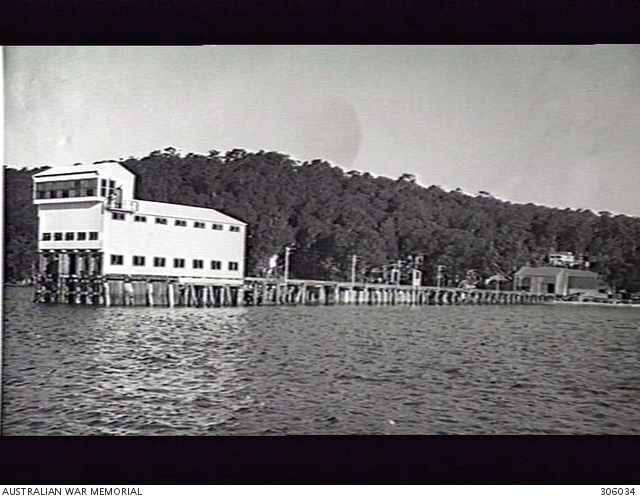
The December 1942 construction of the range was not without difficulty as reported after the war;
The torpedo range at Pittwater was another difficult survey job. - Concrete blocks had to be dropped from a naval tender at a specific point so that the targets could be anchored. It was a difficult task to manoeuvre the vessel into the correct position. Mr. Brett said this was the first survey work ever carried out in Australia by wireless.." IMPORTANCE OF HAVING A SURVEY BASIS. (1947, July 25). Goulburn Evening Post (NSW : 1940 - 1957), p. 7 Edition: Daily and Evening. Retrieved from http://nla.gov.au/nla.news-article103324772
Torpedoes in their original forms were what we today would call ‘mines’. From around 1900 the term 'torpedo' has been used to designate an underwater self-propelled weapon. The first working prototype of the modern self-propelled torpedo was created by a commission placed by Giovanni Luppis(Croatian: Ivan Lupis), an Austrian naval officer from Fiume (now called Rijeka), a port city of the Austro-Hungarian Monarchy (modern Croatia), and Robert Whitehead, an English engineer who was the manager of a town factory. In 1864, Luppis presented Whitehead with the plans of the salvacoste(coastsaver), a floating weapon driven by ropes from the land, and made a contract with him in order to perfect the invention. (1.)
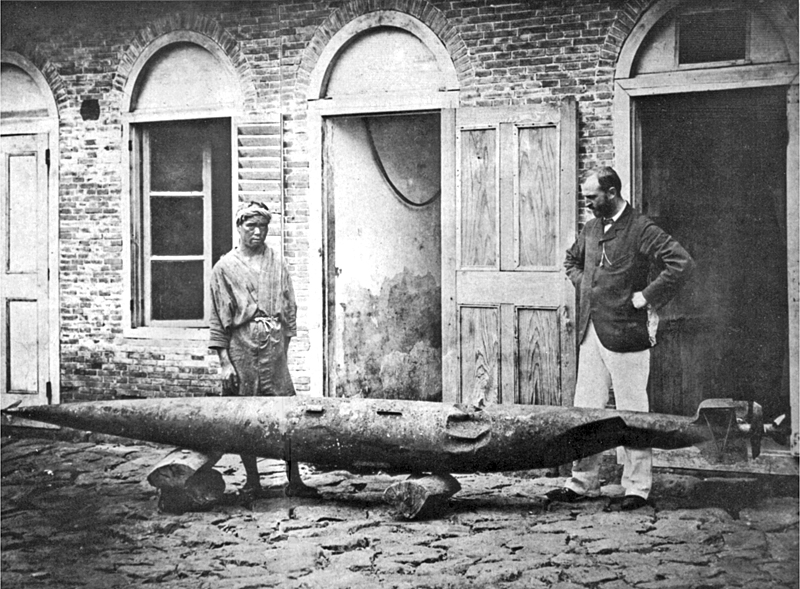
(1.) Robert Whitehead (right) with a rather battered test torpedo, Fiume, c1875. His son John is at left. Retrieved from http://en.wikipedia.org/w/index.php?title=Torpedo&oldid=552553790
The R.A.N. was given responsibility for setting up a Torpedo Factory and supervising manufacture:
The site chosen for the factory was that of the North Sydney Gasworks, and as a result of quick and effective action by the Business Board immediate possession was gained late in 1941. The original plan was to economise by adapting the existing buildings, which were in some respects suitable, but when after several months work had not even begun, the navy sought the aid of Mr Essington Lewis. Lewis decided that to keep pace with the program agreed upon it was necessary to demolish the existing building and erect an entirely new factory. The next day, a Friday, he called a meeting at his office in Melbourne which was attended by all concerned, including representatives of the architects and the contractor from Sydney. A contract was placed that night and the contractor began to clear the site on the following Monday morning. This was a good example of what could be done when it was possible to make a clean cut through red tape. By February 1943 the buildings, known as the Royal Australian Naval Torpedo Factory, were completed, in remarkably short time. The factory was well designed and splendidly equipped; so completely did its structure harmonise with its surroundings that despite the fact that it covered over 100,000 square feet, it was by no means a conspicuous landmark. D P Mellor. Australia in the War of 1939–1945. Series 4 – Civil, Volume V – The Role of Science and Industry (1st edition, 1958), Chapter 13, Torpedoes and Mines, pp. 282-300: retrieved from: http://www.awm.gov.au/histories/second_world_war/volume.asp?levelID=67920
Supervision of all Pittwater torpedo activities was also supervised by the R.A.N.:
Commonwealth Navy Order 287 (1947)
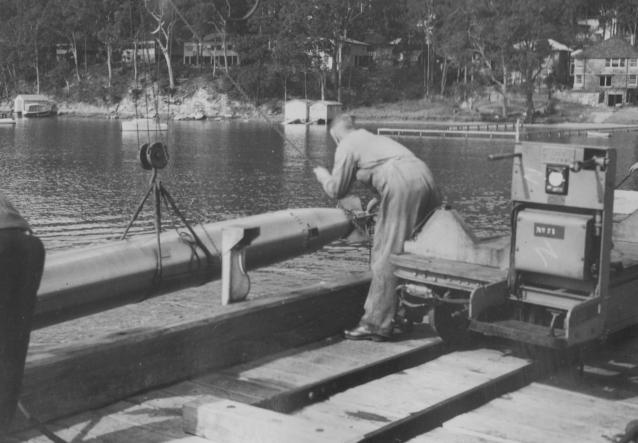 R.A.N. TORPEDO RANGE, PITTWATER, N.S.W.
R.A.N. TORPEDO RANGE, PITTWATER, N.S.W.
The R.A.N. Torpedo Range is situated in Broken Bay, N.S.W., the firing point being on Taylor's Point, Pittwater, and the range extending from there in a northerly direction.
2. Transport of torpedoes is normally carried out by road from the R.A.N. Torpedo Factory, a distance of 22 miles, as no vessel with a draught greater than 12 ft. 6 in. can enter Pittwater. 3. The following firing guns are fitted:—
1—No. 21-in. above water firing tube.
2—No. 18-in. tubes.
1—No. 21-in. submerged firing tube.
There is also a launching cradle for use in running torpedoes not otherwise catered for.
Left: Recovered Torpedo at RAN Torpedo Range, Pittwater, 1949, courtesy Robert Curran.
4. The Torpedo Range workshop is capable of carrying out complete overhauls on all torpedoes.
5. Applications for torpedoes to be ranged should be made by signal to Admiral Superintendent, Sydney, repeated for information to Superintendent, R.A.N. Torpedo Factory.
6. Transport of torpedoes from the ship's side to the range and return will be arranged by the Superintendent, R.A.N. Torpedo Factory.
The Torpedo wharf soon became part of the local landscape, a landmark:
Pittwater: Good catches of mulloway have been made at the torpedo wharf and bream on the flats at Careel Bay. FISHING AND WHERE. (1949, December 4). The Sunday Herald (Sydney, NSW : 1949 - 1953), p. 14 Section: Sporting Section. Retrieved from http://nla.gov.au/nla.news-article28667213
Recovering these devices for a second firing and to examine their devices was part of naval duties.
The Pittwater torpedo range had several firsts in testing these devices, among them:
Australia Makes First Torpedo
SYDNEY, Wed. (AUP). The first Australian built torpedo for use by surface ships was successfully tested at Pittwater torpedo range today. Destroyers and frigates will be the first RAN ships to be equipped with the new 21in. torpedoes. Navy Minister McMahon, who watched the tests today said Australian built torpedoes were part of Australia's contribution to world peace. "The only way to maintain peace," he said, "was for the western democracies to be ready to meet aggression." Australia Makes First Torpedo. (1952, July 30). Singleton Argus (NSW : 1880 - 1954) , p. 3. Retrieved from http://nla.gov.au/nla.news-article82769589
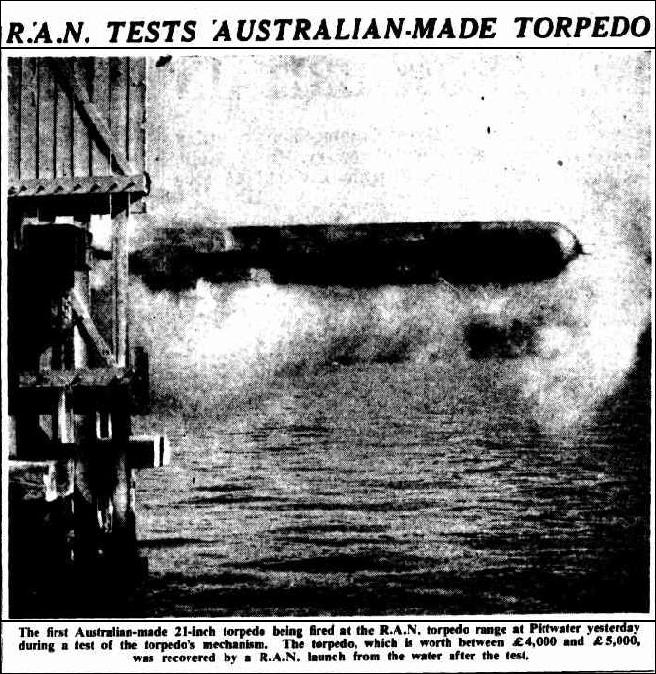
R.A.N. TESTS AUSTRALIAN-MADE TORPEDO. (1952, July 31). The Sydney Morning Herald (NSW : 1842 - 1954), p. 3. Retrieved from http://nla.gov.au/nla.news-article18275646
TORPEDOES TESTED AT PITTWATER
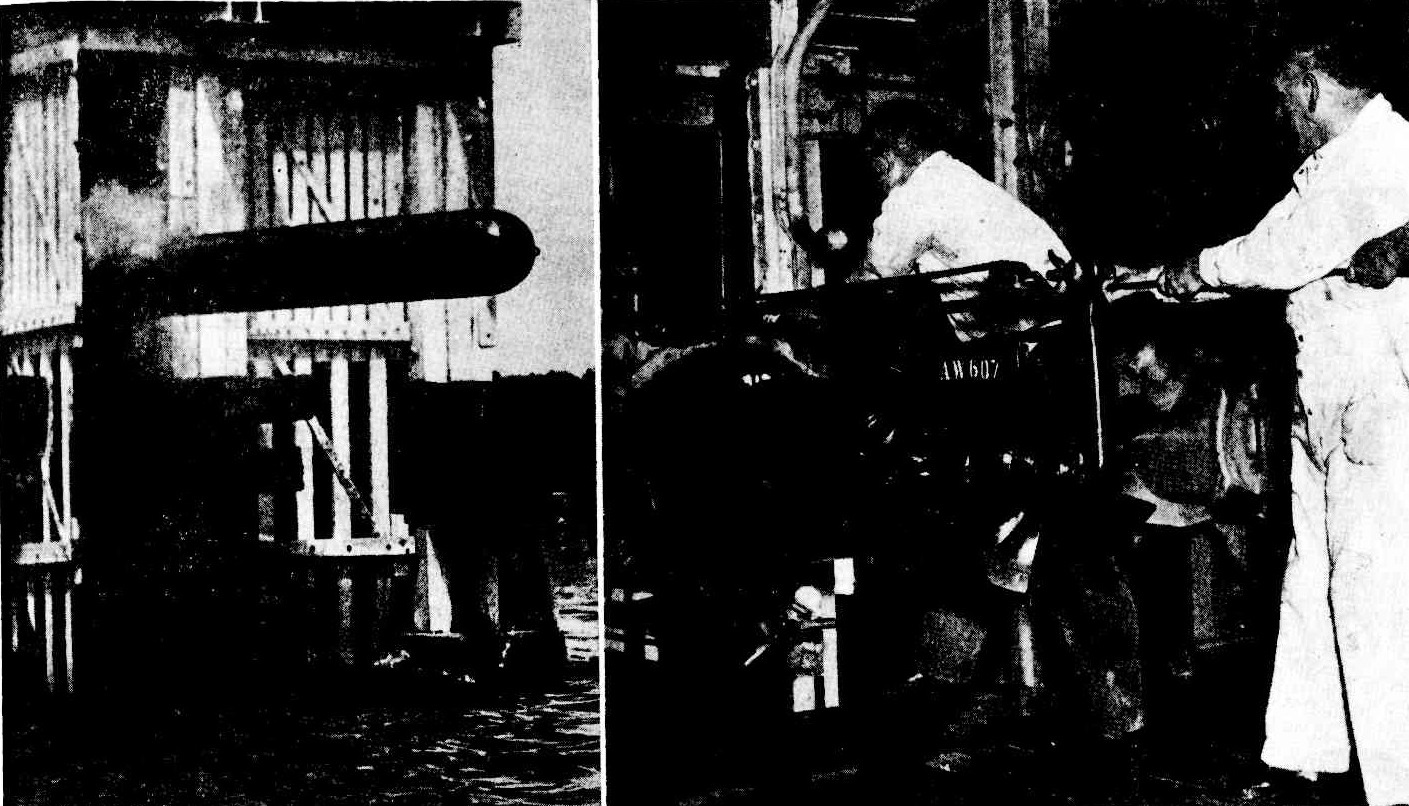
TORPEDOES which will be fired during the Navy's Trafalgar Day demonstration on October 23 were tested at the Pittwater range yesterday morning. These pictures illustrate some aspects of the test. A torpedo is seen (above) emerging from the test tower at the moment of firing, and, on the right, torpedo tradesmen load one of the tubes. TORPEDOES TESTED AT PITTWATER (1954, October 15). The Sydney Morning Herald (NSW : 1842 - 1954), p. 5. Retrieved from http://nla.gov.au/nla.news-article18459189
The Velocity of these missiles caused the structure they were issued from to shake and the wear and tear of the railway track to shift them was hard on the jetty. Maintenance of both structures was required:
Pittwater RAN Torpedo Establishment Strengthening of torpedo firing head and repair to slipway, £34,357, F Jenkins and Sons, Carlton. TENDERS. (1954, October 5). The Sydney Morning Herald(NSW : 1842 - 1954), p. 10. Retrieved from http://nla.gov.au/nla.news-article18456175
Pittwater after World War II had become a more residential area with young families as much as retirees finding such a beautiful place so close to a city centre, and affordable then, more and more attractive.
As with the Prospector Powder Hulk and an Australia no longer under threat of conflict arriving on her shores, those who dwelled on the shores of the estuary began to question why vital training could not be carried out elsewhere.
A few torpedoes going astray, the basis for 'ranging', further underlined a need for the R.A.N. to test elsewhere and use the torpedo wharf and building for another training necessity - older residents recall some of these incidents, as recorded in;
R.A.N. Torpedo Crashes Into Small Island
Sydney, Wednesday – A Royal Australian Navy torpedo ran off course and crashed on to rocks on private property on Scotland Island, Pittwater, to-day. It was the second navy torpedo to "run- away" since August 26th when a torpedo ran on to Clareville Beach, Avalon, 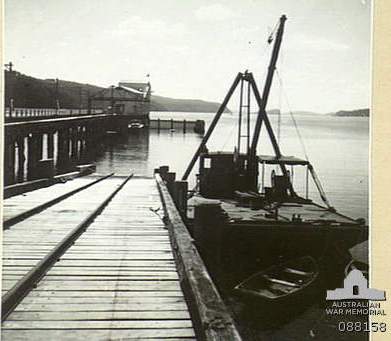 through scores of swimmers narrowly missing pleasure craft moored nearby.
through scores of swimmers narrowly missing pleasure craft moored nearby.
A navy spokesman said today the latest torpedo was fired in routine tests over the navy range in Pittwater, and had not been , loaded. No-one had been injured and no damage had been caused. However, a local resident said the torpedo crashed through a private swimming pool and sea wall on private property.
The Minister for the Navy, Senator Gorton, last August said the testing range would not be moved. He had called for a report on the previous torpedo, but said there was little risk in the present siting of the range. R.A.N. Torpedo Crashes Into Small Island. (1960, January 28). The Canberra Times (ACT : 1926 - 1995), p. 5. Retrieved from http://nla.gov.au/nla.news-article105900778
Torpedo misfire
LONDON, Sunday (AAP). - The Greater London Council has a opened an inquiry into the RAN's misfiring of an un armed torpedo during testing on Thursday. It landed at Clareville Beach, on the Pittwater, North Sydney, near a group of children. Plaque LONDON, Sunday (AAP). The Canberra Times (ACT : 1926 - 1995) Monday 11 December 1978 p 10 Article
In 1983 the firing station let go of its final torpedo. The following year the outer wharf was removed and the centre was converted to a diving and hydrographic school for HMAS Penguin - although divers had been training here prior to that:
RAN diver recovers from the bends
SYDNEY, Thursday. - A naval diver, who suffered the bends and lung injuries while diving yesterday, was recovering today in the naval hospital at HMAS Penguin, Balmoral. The diver, Able Seaman L. L. Platts, 23, of the Naval Clearance Divers Squad, was reported to be in "very good" condition after spending more than three hours in a decompression chamber at a pressure equivalent to 50 feet under water. A police escort cleared the way yesterday for doctors when Platts was taken 20 miles in a portable chamber from Pittwater, where he had been diving, to Balmoral. RAN diver recovers from the bends. (1968, July 26). The Canberra Times (ACT : 1926 - 1995), p. 7. Retrieved from http://nla.gov.au/nla.news-article107064636
The structure and jetty remain part of our Royal Navy Dive School and are currently undergoing long overdue refurbishments which were due to be completed in late 2013. See: http://www.aph.gov.au/Parliamentary_Business/Committees/House_of_Representatives_Committees?url=pwc/hmaspenguin/report/chapter2.htm#_ftnref
Some items from the then Warringah Shire Council records chart the establishment and continuance of the RAN Torpedo facility at Taylor's Reserve:
9/11/1943:
Taylor’s Point Reserve Proposal to Occupy, for the purposes of the Torpedo Station, an additional area of the reserve immediately adjacent to the Station on its western side and in front of the swimming baths: A further letter, dated 8th anat. from the State War Effort Co-ordination Committee, together with the accompanying copy of, a letter received by that Committee from the Department of the Interior further in regard to this Taylor matter was read, and 'explanatory plan received with such letter was displayed. After discussion it was resolved, That the State War Effort Co-ordination Committee be informed that if the Authorities concerned will agree to remove the public baths to a position on the eastern side of the building, as suggested at the conference, the Council will raise no objection to the occupation by the Commonwealth for the duration of the war of the additional area on the western side of the building as shown on' the plan. (Crs. Batho, Langdale) Further in regard to the matter the President pointed out that the torpedo practice operations could extend from Taylor's point Reserve northwards nearly to Lion Island, and would interfere with the use of that portion of Pittwater by the public on occasions. On his motion, seconded by Cr. Batho, it was resolved; - That a letter be sent to the Department of the Navy for an assurance that the mooring of punts in Pittwater will not be a permanent thing after the war's end that a copy of such letter be sent to Mr. Spender, the Federal Parliamentary member for the district.
29/2/1944:
Hon. P.C. Spender, M.H.R. 22/2/44, forwarding letter from the Minister for the Navy regarding torpedo-testing range at Pittwater, in which it is stated that from time to time it will be necessary to run torpedoes for testing purposes, and when this is being done pod flags will be flown from suitably placed pontoons, and a siren sounded to warn persons to keep clear of the range; also that it is not proposed to declare the land adjoining the naval waters a prohibited area, and that the range will be required for the period of the war and possibly longer. "Received"
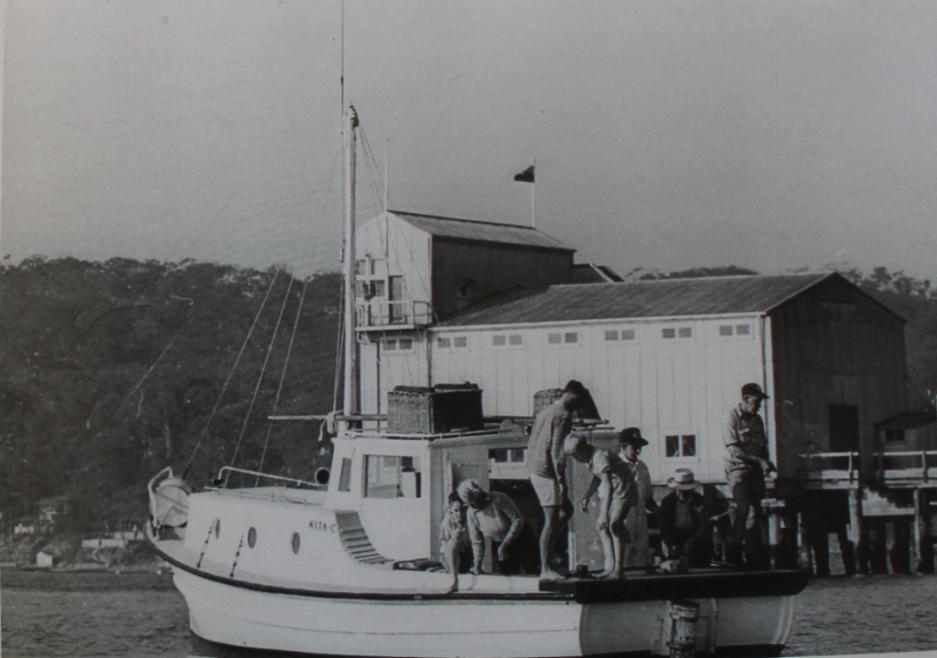
Taylor's Point and Torpedo Testing- Divers Training Annex in 1960's - photo courtesy Gary Cook.
4th March, 1980 3.0 CATEGORY "Re CORRESPONDENCE - 3.1 Royal Australian Navy - Resumption of Torpedo Ranging - Pittwater. (File SF 2246/172-174) Advising that torpedo ranging will be resumed at Pittwater on 9th April, 1980 and that arrangements have been made to place temporary notices on the approaches to the Clareville, Paradise & Snapperman beaches on the days when firings are scheduled; notices will also be published in the local press.
14/04/1992: Submittor (06) Royal Australian Navy (HMAS Penguin) Issue The Navy has provided details on the proposed relocation of a number of boat moorings at Taylors Point. Approximately 80 buoys located in Naval waters off Taylors Point are restricting access to both Naval and public wharfs. The commanding officer of HMAS Penguin, who is responsible for the administration of that part of Pittwater controlled by the RAN has requested the MSB to relocate about 15 buoys. The RAN has never given authorisation for moorings to be located in waters which it controls. The proposed relocation has been made necessary by the requirement to ensure safe and reasonable access to the wharves at Taylors Point. A sketch showing the moorings in question was attached to this submission. The RAN proposes to contact the owners of the moorings before relocation occurs. Comment The Navy's comments have been noted. Further consultation should occur with MSB Waterways Authority regarding a number of moorings to be allocated in the Clareville - Taylors Point area. Further review of the recommended maximum number of moorings in Area 5 or the configuration of this area as indicated in Map 2 and Table 2 in Section 6.3 of the draft DCP/Policy may be required. This matter will be discussed at the next meeting of the Pittwater Planning Advisory Committee.
Royal Australian Navy records show that 2022 marks the 80th Anniversary of the commissioning of HMAS Penguin in 1942.
Now situated in the suburb of Balmoral on Middle Head in Sydney Harbour, HMAS Penguin is surrounded by beaches and parklands and is within 30 minutes drive of the city centre.
HMAS Penguin also has an Annex situated on Pittwater.
HMAS Penguin is part of the Navy’s Fleet Command and was commissioned on 14 July 1942. Its primary role today is to provide trained personnel to the Fleet and is the home of the ADF Diving School (ADFDS), the RAN Hydrographic School and the RAN Medical School.
In 1939, Penguin (Garden Island) was the Navy's main base in Sydney. At the outbreak of war, additional support bases were established in Newcastle, Brisbane and Darwin and each of these was also named Penguin.
In 1941, construction of the existing establishment at Balmoral began. The depot, designed to provide sleeping accommodation for 700 men with necessary administration, support offices and recreational facilities also included the Balmoral Naval Hospital. It was commissioned as Penguin (II) on 14 July 1942 and, when Garden Island was renamed HMAS Kuttabul on January 1st 1943 - in memory of those killed on the ferry Kuttabul in the Japanese midget submarine attack on Sydney Harbour - Penguin (II) became simply Penguin.
Before the Balmoral site was transferred to the Commonwealth Government for Defence use it had been home to the Mosman Golf Club. The former clubhouse remains across the road from the main entrance to Penguin. Before that the site housed the Mosman sewerage works; the swimming pool and the old sandstone tower remain as reminders of this period.
The current Penguin has a proud history and tradition and has filled various important roles reflecting the recurring themes of operations, diving, health care and training.
On commissioning Penguin was the home of the Balmoral Naval Hospital and served as a convalescence centre and as base for the Fairmile B Motor Launches that patrolled Sydney Harbour. After the war, it became the main demobilization base for the Navy. The Balmoral Naval Hospital closed down in October 2006 and Penguin now provides a small Medical Centre for RAN personnel.
Between 1945-1974 Penguin was home to the RAN Seamanship School. HMAS Countersink, a damage control simulator - built from scrap recovered from the battle-damaged HMAS Australia and HMAS Hobart - was constructed on site and until well into the 1980s, as part of the Nuclear, Biological and Chemical Defence School, it continued to train officers and sailors in the art of battle damage repair.
Between 1948-1967 Penguin was home to the Royal Navy's Fourth Submarine Squadron before the First Australian Submarine Squadron was formed in 1968 and home ported at HMAS Platypus, Neutral Bay.
During the period of National Service, 1951-1954, Penguin housed Navy's National Service Recruit School.
In the early 1960s, the RAN Hydrographic School was established at Penguin. With the departure of the Submarine Squadron, the RAN Diving School and the Submarine and Underwater Medicine Unit took up residence at the site. [2.]
Today the Pittwater Annex is still utilised as a training facility for the RAN.
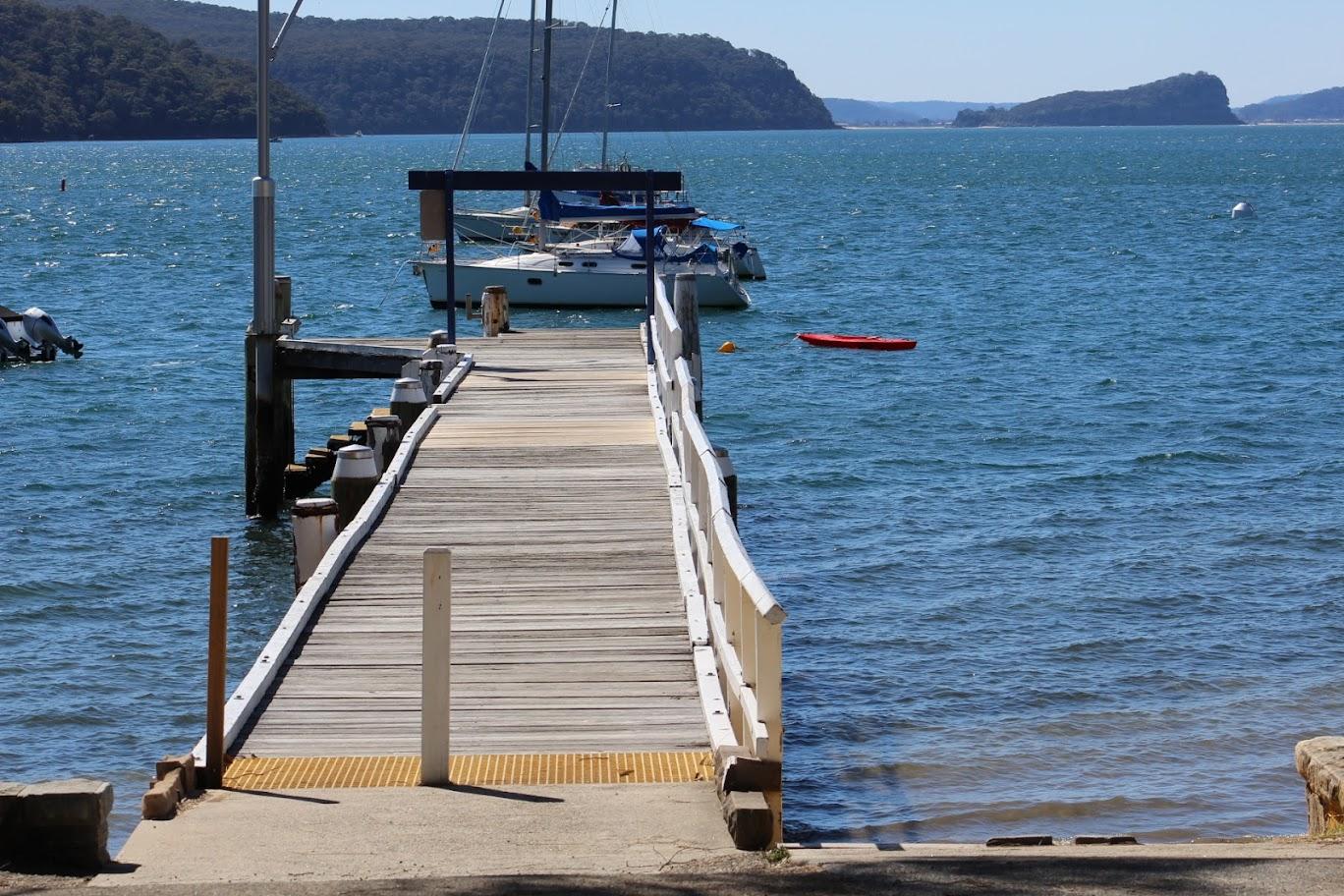
1. Nan Bosler, The Fascinating history of Pittwater, Part two. 1998
2. HMAS Penguin, Royal Australian Navy webpage: https://www.navy.gov.au/establishments/hmas-penguin